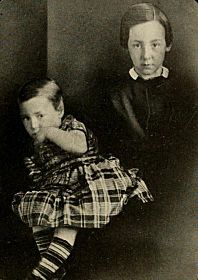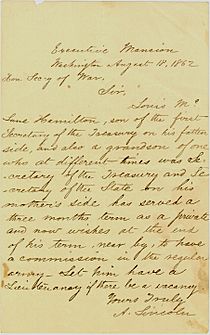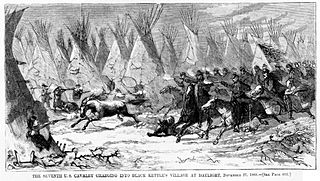Louis McLane Hamilton facts for kids
Quick facts for kids
Louis McLane Hamilton
|
|
|---|---|

Captain Louis McLane Hamilton
|
|
| Born | July 21, 1844 New York City, US |
| Died | November 27, 1868 (aged 24) Washita Valley, Indian Territory, US |
| Buried |
|
| Allegiance | |
| Service/ |
|
| Years of service | 1862–1868 |
| Rank | |
| Commands held | |
| Battles/wars | |
| Relations | Hamilton family |
Louis McLane Hamilton (born July 21, 1844 – died November 27, 1868) was a brave cavalry officer in the United States Army. He fought in two big conflicts: the American Civil War and the American Indian Wars. Louis was a captain who served with General George Armstrong Custer in what is now Oklahoma. He sadly died at age 24 while leading his soldiers in a fight called the Battle of Washita River.
Contents
Early Life and Family Connections
Louis McLane Hamilton was born in New York City on July 21, 1844. He came from a very famous family. His grandfather was Alexander Hamilton, one of the Founding Fathers of America.
Louis's father, Philip Hamilton (the second), was the youngest son of Alexander Hamilton and Elizabeth Schuyler Hamilton. His mother was Rebecca McLane. Her father, Louis McLane, was also a very important person. He served in the U.S. House and Senate. He was also the Secretary of the Treasury and Secretary of State for the United States.
Louis had a younger brother named Allan McLane Hamilton. Allan became a well-known psychiatrist.
Military Career and Brave Service
Fighting in the American Civil War
When Louis was just 17, in June 1862, he joined the army as a volunteer private. He served for three months at Harper's Ferry, West Virginia. After that, he went home to Poughkeepsie, New York. There, he immediately started gathering a group of volunteers to join the army.
On August 18, 1862, President Abraham Lincoln wrote a letter to the Secretary of War, Edwin Stanton. Lincoln suggested that Louis Hamilton should become a lieutenant in the regular army. On September 21, 1862, Louis was made a second lieutenant in the 3rd U.S. Infantry Regiment.
Lieutenant Hamilton led a company of soldiers in the Battle of Fredericksburg in December 1862. He also led them in the Battle of Chancellorsville in May 1863. During this battle, he helped cover the army's retreat across the Rappahannock River. Because of his "gallant and meritorious conduct" (meaning brave and excellent actions) during this time, he was given a special role. The very next day, he joined the staff of General Romeyn B. Ayres.
While serving with the Army of the Potomac, Louis was promoted to first lieutenant. He also received special honors twice for his bravery. These honors were for his actions during the battles at Chancellorsville and Gettysburg. He also fought in the Siege of Petersburg and at the Battle of Appomattox Court House.
Service After the Civil War
In July 1866, Louis Hamilton became a captain in the new 7th U.S. Cavalry. This regiment was led by Lieutenant Colonel George Armstrong Custer. Louis was the youngest officer of his rank in the regular army at that time.
Captain Hamilton was first sent to command Fort Lyon in Colorado. Later, during the American Indian Wars, he served under General Custer. This service took place in the Indian Territory, which is now Oklahoma.
On June 24, 1867, Captain Hamilton was in charge of a small group of soldiers. They were on an expedition with General Winfield Scott Hancock. Captain Hamilton helped prevent an attack by Native American warriors near the Republican River. He pushed back 45 attacking Sioux warriors while chasing a group led by Pawnee Killer.
On Thanksgiving Day, November 26, 1868, Captain Hamilton was the "officer of the day" for General Custer's command. This job usually meant he would stay behind with the supply wagons. However, Louis really wanted to be with his soldiers. He asked his commander if he could go with his squadron into the fight. Custer agreed, and Hamilton was allowed to lead his soldiers into battle.
The very next day, November 27, 1868, Captain Hamilton was the first soldier to die in the Battle of Washita River. He was killed while leading the first charge of troops in Custer's attack. This attack was on Black Kettle's Cheyenne camp. Hamilton's squadron was placed in the middle of the attack formation. They were meant to charge the camp while riding their horses.
At dawn, Hamilton was heard telling his men to "keep cool, fire low, and not too rapidly." He led his squadron "in splendid style right up to the enemy's lodges." There, he "fell dead from his horse, shot through the heart." He was hit by a bullet from a long rifle fired by someone hidden in a wigwam.
Legacy and Remembrance
Louis Hamilton was buried a week later, on December 4, 1868, at Fort Supply. Later, his body was moved to the Poughkeepsie Rural Cemetery in Poughkeepsie, New York. He was buried in a family plot where his parents were later laid to rest.
A few days after Louis's death, another captain from the 7th Cavalry Regiment wrote a letter. This letter was sent to the Army and Navy Journal to remember Hamilton. Captain Robert M. West described Hamilton's brave charge. He wrote that Hamilton's goal was to be a perfect soldier. He was brave in everything he did. Captain West also said that Louis was gentle and kind in his everyday life. He had a strong mind and was very intelligent.
After his death, Louis Hamilton was given a special honor. He was promoted to the rank of major for his bravery in leading his command.
His nephew, Louis McLane Hamilton (1876–1911), was named in his memory. He was the only child of Louis's brother, Allan McLane Hamilton.




